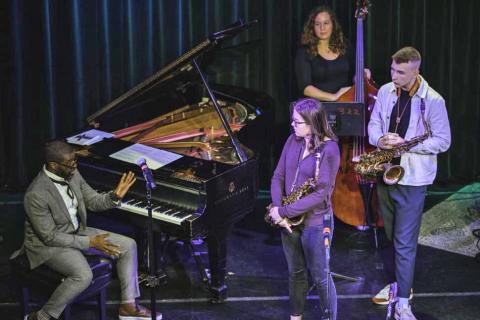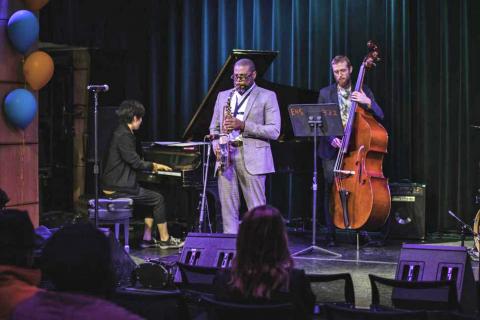Antonio Hart: A Good Practice Session Should Bring You to Tears

Visiting Artist Antonio Hart B.M. '91 recently led a clinic and workshop for students.
Image by Adam Ridhwan

Hart invited students to bring their horns to the stage, where he could work directly with them.
Image by Adam Ridhwan

Before the clinic, Hart performed his multi-meter original tune, "Forward Motion," with a student ensemble.
Image by Adam Ridhwan
Saxophonist and music educator Antonio Hart B.M. ’91 wants you to know that, even if he’s standing on a stage, he sees everyone as equal. “We’re on the same plane,” he said at the beginning of a recent clinic and workshop on campus, sponsored by the Woodwind Department, where his main goal was to help students on their musical journeys. “I have experiences I want to share with you because if I can make your road a little straighter than mine, then my job has been successful,” he said.
His advice and answers to student questions were thus squarely aimed at the practical. What follows are selected snippets of his advice and his career experience, from starting out at Berklee as a student, to touring the world as both a side player and bandleader.
"If I can make myself cry when I’m playing, I feel like I’m doing something.”
—Antonio Hart B.M. '91
How to Network
Hart stressed to the students that the people they’re connecting with on campus are most likely going to be key players in building their career connections. “Some of these people that you’re in class with are going to be the people that you play with in the future and that you’re going to network with, so it’s important to build relationships,” he said.
By way of a poignant example, Hart talked emphatically about first meeting the late trumpet legend, Roy Hargrove '89, who Hart traveled the world with after they connected as students. Even before he was on campus, Hargrove already had a reputation as a hotshot player, and Hart admits that he and other students were skeptical at first. “We’d heard about Roy,” Hart said. “He was already famous—at 17 years old, this wonder kid—but we were the cats at Berklee, right? We had our chests in the air, like, ‘Who’s this trumpet player? Tell him to come down to Wally’s [Cafe Jazz Club].’” Hargrove took the invitation, showing up at Wally’s, as Hart reports, around midnight, wearing sunglasses and a tweed jacket, every bit looking like his larger-than-life reputation. But when he actually got up to play, Hart and his friends were speechless.
Take a listen to our tribute playlist to Roy Hargrove on Spotify:
How to Practice and Improve
Despite Grammy nominations and decades of recordings and performances with the likes of Dave Holland and the Dizzy Gillespie Big Band, when Hart hits the woodshed, it’s nothing glamorous. “When I go into the practice room, I practice. I don’t go in there to sound good,” he said, pointing out that he focuses on both fundamentals and ways to find emotional resonance in compositions. “I’ll just put on a recording and play it, and try different ways of approaching the composition, and see if I can move myself. If I can make myself cry when I’m playing, I feel like I’m doing something.”
Given Hart’s role as a professor at Queens College in New York—he majored in music education while at Berklee—it's no surprise that he had a teacher’s answer ready when one student asked how he could improve his playing: “[There are] four things—first of all is listen, that’s the most important thing. Then you practice, and then you play, and then you go back and think about it.” Then what, you might ask? “Then you do it all over again.”
